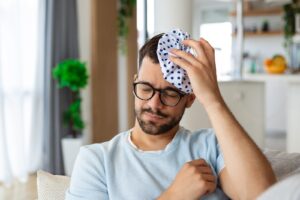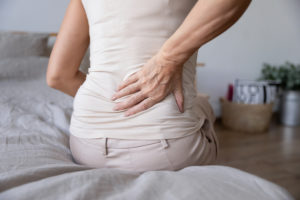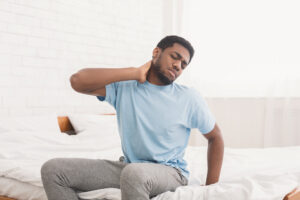Painsomnia
Painsomnia is a term that describes how chronic pain can interfere with a person’s sleep. While painsomnia is not a medical term, it is used anecdotally to describe a common challenge experienced by people living with chronic pain.
Learn more about painsomnia as well as some of the conditions that may interfere with sleep. Understanding treatments and strategies for living with painsomnia may help people combat the sleep-disrupting effects of chronic pain.
What is Painsomnia?
Painsomnia is a term created by patients to describe difficulty falling or staying asleep due to chronic pain. Although the term painsomnia may not be used by medical professionals, insomnia due to a medical condition is recognized by the American Academy of Sleep Medicine as a sleep disorder.
Pain is an unpleasant sensation that alerts the body to potential harm. Acute or short-term pain occurs suddenly and typically goes away with treatment, whereas chronic pain is long-lasting. More than 25% of people in the United States report experiencing chronic pain.
Insomnia is a common sleep disorder characterized by challenges with falling asleep, staying asleep, or not falling back asleep after waking up at night. An estimated 75% of people who live with chronic pain report symptoms of insomnia.
Chronic pain and sleep issues have a two-way relationship that can lead to a frustrating cycle of discomfort and sleeplessness. Research shows that pain interferes with sleep and, at the same time, poor sleep can make a person more sensitive to pain.

Symptoms of Painsomnia
People with chronic pain have varying levels of discomfort and sleep issues, so the experience of painsomnia may be different for everyone.
Pain may be diagnosed as chronic if it persists for more than three months, comes and goes over several months or longer, or is associated with a chronic health condition like arthritis, diabetes, or cancer. People who live with chronic pain may have sleep issues, as well as other symptoms like tiredness, appetite loss, digestive issues, and mood changes.
Insomnia involves insufficient sleep or poor sleep quality, even though a person has sufficient opportunities to sleep. People with insomnia also have daytime impairments, such as fatigue, trouble concentrating, low energy, and excessive thoughts or worry about sleep.
Causes of Painsomnia
Although the connection between pain and insomnia is not fully understood, studies suggest that a person’s sensitivity to pain follows a circadian rhythm, or 24-hour cycle. Sensitivity to certain types of pain may be greatest at night.
A number of chronic medical conditions can cause painsomnia. Conditions that may contribute to pain and insomnia include autoimmune disorders, degenerative disorders, and neuromuscular disorders.
Rheumatoid Arthritis
People with rheumatoid arthritis (RA) experience stiffness, swelling, and pain in the joints, caused by the immune system attacking healthy joint tissue. Sleep disturbances in RA may be caused by pain in the joints or other areas such as the lungs, heart, and nerves.
Osteoarthritis
Osteoarthritis (OA) is the most common type of arthritis. In OA, tissues in joints degrade over time, causing swelling, pain, and potential loss of motion. Pain caused by OA often gets worse late in the afternoon and evening. People with OA may also experience pain during the night that interrupts their sleep.
Axial Spondyloarthritis
Axial spondyloarthritis is a type of arthritis that causes pain in the lower back and neck which can limit mobility as the disease progresses. Pain from axial spondyloarthritis may be improved with exercise but typically does not improve with rest. Many people with the disease experience pain at night that contributes to poor sleep.
Fibromyalgia
Fibromyalgia causes pain throughout the body, fatigue, disturbed sleep, and other physical concerns. People with fibromyalgia tend to feel unrefreshed even after a full night of sleep and commonly develop sleep disorders that make rest difficult, such as restless leg syndrome and sleep apnea.
Peripheral Neuropathy
Peripheral neuropathy describes conditions in which the nerves that relay information to and from the brain or spinal cord become damaged. Symptoms of peripheral neuropathy depend on which nerves are damaged and may include pain, numbness, muscle weakness, digestive problems, and other health issues. Some types of nerve pain can become stronger at night and interrupt a person’s sleep.
Endometriosis
Endometriosis is a disease in which endometrial tissue, which normally lines the uterus, grows in other places in the body. Symptoms of endometriosis can include pelvic pain, painful cramps during menstruation, and pain in the intestines or abdomen. Because of nighttime pain, endometriosis can affect both the time it takes to fall asleep and sleep quality.
How is Painsomnia Treated?
Treatment for painsomnia depends on a person’s sleep-related symptoms as well as the source of their chronic pain. It may be difficult to determine whether pain is causing a person’s insomnia or vice versa, so doctors typically treat both the cause of pain and the insomnia symptoms simultaneously.
Chronic pain is treated based on the source of discomfort and may include several types of treatment:
- Pain medications
- Physical or occupational therapy
- Acupuncture, massage, or transcutaneous electrical nerve stimulation
- Psychological support
- Specialty treatment at a pain clinic
Treatment for insomnia varies based on the severity of symptoms and may involve improving sleep hygiene, cognitive-behavioral therapy for insomnia, and medications that aid sleep.
Living with Painsomnia
For people living with painsomnia, a number of strategies may help improve sleep and break the cycle of poor sleep and nighttime discomfort.
Improving Sleep Hygiene
Sleep hygiene refers to healthy sleep habits. Practicing good sleep hygiene can help you sleep better at night.
- Keep a regular sleep schedule: Even on the weekends, it is important to go to bed and wake up near the same time every day.
- Create a quality sleep environment: A bedroom should be dark, quiet, and kept at a cool temperature to facilitate quality sleep.
- Don’t toss and turn: If you are unable to fall asleep after 20 minutes, leave the bedroom and do a relaxing activity until you are tired.
- Avoid light before bedtime: Light from TVs, computers, and cell phones can make it more difficult to fall asleep.
- Exercise regularly: Daytime exercise can make it easier to fall asleep at night, but avoid exercising less than two hours before bedtime.
- Watch your eating habits: To support healthy sleep, consuming caffeine after lunchtime or alcohol near bedtime is not recommended. Also avoid heavy meals and late-night snacking that can keep you awake.
Meditation and Relaxation Techniques
Meditation and relaxation are components of cognitive-behavioral therapy for insomnia (CBT-I), a treatment that focuses on the thoughts and actions that affect sleep. Along with other aspects of CBT-I, meditation, mindfulness, and muscle relaxation may reduce the symptoms of both chronic pain and insomnia.
- Meditation: Meditation entails focusing your attention to relax the body. Attention can be placed on your breathing, an object, or a particular image or phrase. Even when used on its own, meditation has been shown to have at least a small impact on reducing symptoms of pain and improving quality of life.
- Mindfulness: Mindfulness involves observing what is happening both inside and around you without judgment. In addition to being used during meditation, mindfulness practices can also be integrated into everyday activities, like eating, walking, or socializing. Studies show that mindfulness may help people sleep better and cope with pain.
- Progressive muscle relaxation: Progressive muscle relaxation is a technique that eases the muscles in a certain sequence. To practice, you gently squeeze muscles for a few moments before relaxing them, beginning with facial muscles and then gradually shifting to muscle groups lower in the body.
Talk to Your Doctor
If you experience painsomnia, be sure to talk to your health care provider. Your doctor can evaluate your symptoms and discuss treatment options that address the effects of both insomnia and chronic pain.

Still have questions? Ask our community!
Join our Sleep Care Community — a trusted hub of sleep health professionals, product specialists, and people just like you. Whether you need expert sleep advice for your insomnia or you’re searching for the perfect mattress, we’ve got you covered. Get personalized guidance from the experts who know sleep best.
References
2 Sources
-
Dydyk, A. M. & Conermann, T. (2021, November 11). Chronic pain. In StatPearls. StatPearls Publishing., Retrieved May 29, 2022, from
https://www.ncbi.nlm.nih.gov/books/NBK553030/ -
Hilton, L., Hempel, S., Ewing, B. A., Apaydin, E., Xenakis, L., Newberry, S., Colaiaco, B., Maher, A. R., Shanman, R. M., Sorbero, M. E., & Maglione, M. A. (2016). Mindfulness meditation for chronic pain: Systematic review and meta-analysis. Annals of Behavioral Medicine, 51(2), 199–213.
https://pubmed.ncbi.nlm.nih.gov/27658913/

































































